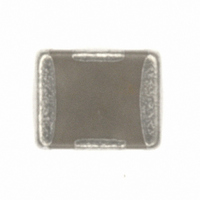160X41W105MV4E Johanson Dielectrics Inc, 160X41W105MV4E Datasheet - Page 6

160X41W105MV4E
Manufacturer Part Number
160X41W105MV4E
Description
CAP CER X2Y 1.0UF 16V X7R 1210
Manufacturer
Johanson Dielectrics Inc
Series
X2Y®r
Datasheet
1.S-X2Y-MTR.pdf
(8 pages)
Specifications of 160X41W105MV4E
Capacitance
1.0µF
Voltage - Rated
16V
Tolerance
±20%
Temperature Coefficient
X7R
Mounting Type
Surface Mount, MLCC
Operating Temperature
-55°C ~ 125°C
Features
Low Inductance
Applications
Bypass, Decoupling
Package / Case
1210 (3225 Metric)
Size / Dimension
0.125" L x 0.098" W (3.18mm x 2.49mm)
Thickness
1.78mm Max
Dielectric Characteristic
X7R
Capacitance Tolerance
± 20%
Voltage Rating
16VDC
Capacitor Case Style
1210
No. Of Pins
2
Capacitor Mounting
SMD
Operating Temperature Range
-55°C To
Rohs Compliant
Yes
Lead Free Status / RoHS Status
Lead free / RoHS Compliant
Ratings
-
Lead Spacing
-
Other names
709-1108-2
S
L
Ceramic capacitors (X2Y and standard MLC types) can be easily damaged when hand soldered. Thermal cracking of the ceramic
body is often invisible even under a microscope. Factors that increase thermal cracking risk:
1. 4 terminals to solder can increase hand-soldering time and temperature exposure
2. Pb-free solders have higher reflow temperatures
3. Low inductance connections to ground are inherently good heat-sinks
A damaged component may exhibit a short circuit immediately and not recover, or may operate with intermittent Insulation Resistance
(IR) levels. If you are not achieving expected results and have followed the other guidelines carefully, check to see you are adhering to
the soldering guidelines below:
• Always pre-heat the PCB and component to within 50°C of solder reflow temperature at 2°C/sec. maximum.
• Use contact-less hand solder tools such as a hot air pencil, IR lamp, etc.
• Avoid over-heating of the ceramic component, temperature limit: 260°C for 20-30 seconds max.
• Use a soldering iron as last resort; 20W max. tip, NO CONTACT with ceramic, limit solder time to 5 seconds max.
A reliable, cost effective prototype PCB reflow soldering process is possible using a household toaster oven. There are several good
procedures available on-line by googling “Toaster Oven Soldering”
O
X2Y capacitors deliver excellent performance in EMI/RFI fi ltering and Power Bypass applications. Physical and electrical placement
on the PCB is critical in achieving good results. A low inductance, dual ground connection is mandatory.
EMI Filter Applications
inductance connections and should be avoided. See detailed application note
PDN / Power Bypass Applications
recommended layout against a poor layout. Because of its long extents from
device terminals to vias, and the wide via separation, the poor layout exhibits
approximately 200% L1 inductance, and 150% L2 inductance compared to
recommended X2Y layouts. See detailed application note
Mounting.
6
OLDER
AB
G
PTIMIZING
X
Y
V
U
Z
E
VALUATION
0.020
0.020
0.024
0.015
0.039
0.064
Fig. 1
P
0402 (X07)
IN
Use of solder mask beneath component is not recommended because of flux/contaminant entrapment.
AD
X2Y P
R
0.51
0.51
0.61
0.38
0.99
1.63
mm
ECOMMENDATIONS
S
OLDERING
ERFORMANCE ON THE
0.035
0.025
0.040
0.020
0.060
0.090
0603 (X14)
IN
Low inductance PCB routing examples are shown in fi gures 1 and 2. Figures 3-5 show unbalanced and high
0.89
0.64
1.02
0.51
1.52
2.29
mm
P
RECAUTIONS
0.050
0.035
0.050
0.022
0.080
0.120
0805 (X15)
Fig. 2
IN
Figures on right compare the X2Y
1.27
0.89
1.27
0.56
2.03
3.05
mm
PCB
www.johanson dielectrics.com
0.065
0.040
0.080
0.040
0.120
0.160
1206 (X18)
IN
1.65
1.02
2.03
1.02
3.05
4.06
X2Y Power Bypass
mm
0.100
0.040
0.080
0.045
0.160
0.160
Fig. 3
1210 (X41)
IN
2.54
1.02
2.03
1.14
4.06
4.06
mm
X2Y EMI FIlter Evaluation and PCB Design
0.100
0.040
0.100
0.045
0.160
0.180
1410 (X44)
IN
2.54
1.02
2.54
1.14
4.06
4.57
mm
Recommended X2Y
Bypass Layout
Fig. 4
0.125
0.040
0.130
0.045
0.190
0.210
1812 (X43)
IN
3.18
1.02
3.30
1.14
4.83
5.33
mm
X
Y
Fig. 5
Z
V
G
V
V
V
Guidelines.
U













